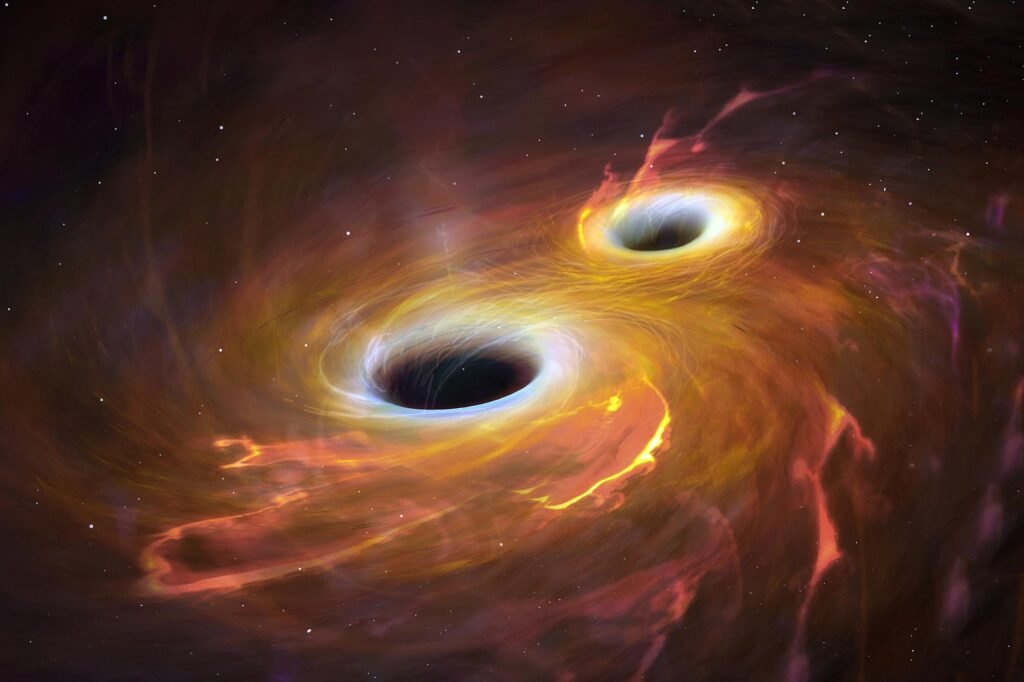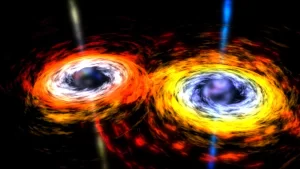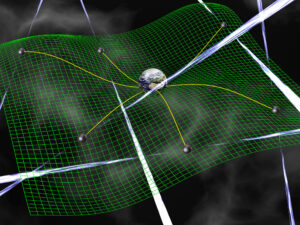Missing Seeds: Mysterious Enigma of Supermassive Black Holes

Missing Seeds: Mysterious Enigma of Supermassive Black Holes
In the tremendous lawn of the universe, the heaviest black holes grew from seeds. Nourished via way of means of the fueloline and dirt they ate up, or via way of means of merging with different dense gadgets, those seeds grew in length and heft to shape the facilities of galaxies, consisting of our personal Milky Way. But in contrast to withinside the realm of plants, the seeds of massive black holes should had been black holes, too. And nobody has ever observed those seeds — yet.
One concept is that supermassive black holes — the equal of loads of hundreds to billions of Suns in mass — grew from a populace of smaller black holes that has in no way been visible. This elusive organization, the “intermediate-mass black holes,” could weigh in someplace among one hundred and one hundred,000 Suns. Among the loads of black holes observed to this point, there had been masses of especially small ones, however none for positive withinside the intermediate mass-variety “barren region.”
Scientists are running with effective area telescopes from NASA, in addition to different observatories, to song down far-flung gadgets that suit the outline of those uncommon entities. They have observed dozens of feasible applicants, and are running closer tos confirming them as black holes. But even though they do, that opens up an entire new thriller: How did intermediate-mass black holes shape?
“What is fascinating, and why humans have spent a lot time looking for those intermediate-mass black holes, is as it sheds mild on methods that befell withinside the early universe— what had been the loads of relic black holes, or new formation mechanisms for black holes that we haven’t concept of yet,” stated Fiona Harrison, professor of physics at Caltech in Pasadena, California, and major investigator for NASA’s NuSTAR mission.
Black Hole 101
A black hollow is an incredibly dense item in area from which no mild can escape. When cloth falls right into a black hollow, it has no manner out. And the greater a black hollow eats, the greater it grows in each mass and length.
The smallest black holes are referred to as “stellar mass,” with among 1 and one hundred instances the mass of the Sun. They shape whilst stars explode in violent methods referred to as supernovae.
Supermassive black holes, on the opposite hand, are the primary anchors of huge galaxies – for example, our Sun and all different stars withinside the Milky Way orbit a black hollow referred to as Sagittarius A* that weighs approximately 4.1 million sun loads. An even heavier black hollow — at a whopping 6.five billion sun loads — serves because the centerpiece for the galaxy Messier 87 (M87). M87’s supermassive black hollow seems withinside the well-known picture from the Event Horizon Telescope, displaying a black hollow and its “shadow” for the first actual time. This shadow is due to the occasion horizon, the black hollow’s factor of no return, bending and taking pictures mild with its robust gravity.
Supermassive black holes generally tend to have disks of cloth round them referred to as “accretion disks,” product of extraordinarily warm, excessive-strength debris that shine brilliant as they get toward the occasion horizon— the black hollow’s area of no return. Those that make their disks shine brightly due to the fact they devour plenty are referred to as “lively galactic nuclei.”
The density of count had to create a black hollow is mind-boggling. To make a black hollow 50 instances the mass of the Sun, you’ll must percent the equal of fifty Suns right into a ball much less than two hundred miles (three hundred kilometers) across. But withinside the case of M87’s centerpiece, it’s far as aleven though 6.five billion Suns had been compressed right into a ball wider than the orbit of Pluto. In each cases, the density is so excessive that the authentic cloth should fall apart right into a singularity— a rip withinside the cloth of area-time.
Key to the thriller of black holes’ origins is the bodily restriction on how speedy they are able to develop. Even the massive monsters on the facilities of galaxies have obstacles on their feeding frenzies, due to the fact a positive quantity of cloth is driven returned via way of means of the excessive-strength radiation coming from warm debris increased close to the occasion horizon. Just via way of means of consuming surrounding cloth, a low-mass black hollow may best be capable of double its mass in 30 million years, for example.
“If you begin from a mass of fifty sun loads, you certainly can not develop it to at least one billion sun loads over 1 billion years,” stated Igor Chilingarian, an astrophysicist on the Smithsonian Astrophysical Observatory, Cambridge, Massachusetts, and Moscow State University. But, “as we know, there are supermassive black holes that exist much less than 1 billion years after the formation of the universe.”
How to make a black hollow you may’t see
Early withinside the universe’s history, the seed of an intermediate-mass black hollow ought to have shaped both from the fall apart of a huge, dense fueloline cloud or from a supernova explosion. The first actual stars that exploded in our universe had natural hydrogen and helium of their outer layers with heavier factors focused withinside the core. This is a recipe for a miles greater big black hollow than exploding contemporary-day stars, which are “polluted” with heavy factors of their outer layers and consequently lose greater mass thru their stellar winds.
“If we’re forming black holes with one hundred sun loads early withinside the universe, a number of them ought to merge together, however you essentially then ought to produce an entire variety of loads, after which a number of them ought to nevertheless be round,” stated Tod Strohmayer, astrophysicist at NASA’s Goddard Space Flight Center, Greenbelt, Maryland. “So then, wherein are they, in the event that they did shape?”
One clue that intermediate-mass black holes ought to nevertheless be available got here from the National Science Foundation’s Laser Interferometer Gravitational-Wave Observatory, LIGO, a collaboration among Caltech and the Massachusetts Institute of Technology. LIGO detectors, blended with a European facility in Italy named Virgo, are turning up many distinct mergers of black holes thru ripples in area-time referred to as gravitational waves.
In 2016, LIGO introduced one of the maximum essential medical discoveries of the remaining half-century: the primary gravitational wave detection. Specifically, the detectors primarily based totally in Livingston, Louisiana, and Hanford, Washington, picked up the sign of black holes merging. The loads of those black holes: 29 and 36 instances the mass of the Sun, respectively, amazed scientists. While those are nevertheless now no longer technically intermediate-mass, they may be huge sufficient to elevate eyebrows.
It’s feasible that each one of the intermediate-mass black holes have already merged, however additionally that generation hasn’t been quality tuned to discover them.
So wherein are they?
Looking for black holes withinside the intermediate-mass barren region is difficult due to the fact black holes themselves emit no mild. However, scientists can search for particular telltale symptoms and symptoms the usage of state-of-the-art telescopes and different devices. For example, due to the fact the go with the drift of count onto a black hollow isn’t always constant, the clumpiness of ate up cloth reasons positive versions in mild output withinside the environment. Such modifications may be visible greater fast in smaller black holes than large ones.
“On a timescale of hours, you may do the observational marketing campaign that for classical lively galactic nuclei takes months,” Chilingarian stated.
The maximum promising intermediate-mass black hollow candidate is referred to as HLX-1, with a mass of approximately 20,000 instances the Sun’s. HLX-1 stands for “Hyper-Luminous X-ray supply 1,” and its strength output is lots better than Sun-like stars. It become found in 2009 via way of means of Australian astronomer Sean Farrell, the usage of the European Space Agency’s XMM-Newton X-ray area telescope. A 2012 observe the usage of NASA’s Hubble and Swift area telescopes observed recommendations of a cluster of younger blue stars orbiting this item. It may also have as soon as been the middle of a dwarf galaxy that become swallowed via way of means of the bigger galaxy ESO 243-49. Many scientists take into account HLX-1 a established intermediate-mass black hollow, Harrison stated.
“The colorings of X-ray mild it emits, and simply the manner it behaves, may be very just like a black hollow,” Harrison stated. “A lot of humans, together with my organization, have packages to locate matters that appear like HLX-1, however to this point none are regular. But the search is going on.”
Less-brilliant gadgets that would be intermediate-mass black holes are referred to as ultraluminous X-ray sources, or ULXs. A flickering ULX referred to as NGC 5408 X-1 has been specifically interesting to scientists seeking out intermediate-mass black holes. But NASA’s NuSTAR and Chandra X-ray observatories astonished scientists via way of means of revealing that many ULX gadgets aren’t black holes— instead, they may be pulsars, extraordinarily dense stellar remnants that seem to pulse like lighthouses.
M82 X-1, the brightest X-ray supply withinside the galaxy M82, is every other very brilliant item that appears to flicker on timescales regular with an intermediate-mass black hollow. These modifications in brightness are associated with the mass of the black hollow, and are due to orbiting cloth close to the internal area of the accretion disk. A 2014 observe checked out particular versions in X-ray mild and predicted that M82 X-1 has a mass of approximately four hundred Suns. Scientists used archival statistics from NASA’s Rossi X-ray Timing Explorer (RXTE) satellite tv for pc to observe those X-ray brightness versions.
Most recently, scientists investigated a larger organization of feasible intermediate-mass black holes. In 2018, Chilingarian and co-workers defined a pattern of 10 applicants via way of means of re-reading optical statistics from the Sloan Digital Sky Survey and matching the preliminary potentialities with X-ray statistics from Chandra and XMM-Newton. They at the moment are following up with ground-primarily based totally telescopes in Chile and Arizona. Mar Mezcua of Spain’s Institute for Space Sciences led a separate 2018 observe, additionally the usage of Chandra statistics, locating forty developing black holes in dwarf galaxies that would be in that unique intermediate mass variety. But Mezcua and collaborators argue those black holes shaped at the beginning withinside the fall apart of massive clouds, in preference to via way of means of originating in stellar explosions.
What’s next
Dwarf galaxies are exciting locations to hold searching due to the fact, in theory, smaller famous person structures ought to host black holes of an awful lot decrease mass than the ones observed withinside the facilities of large galaxies like our personal.
Scientists also are looking globular clusters — round concentrations of stars positioned withinside the outskirts of the Milky Way and different galaxies — for the identical reason.
“It might be there are black holes like that, in galaxies like that, however in the event that they’re now no longer accreting a number of count, it is probably tough to peer them,” Strohmayer stated.
Intermediate-mass black hollow hunters eagerly wait for the release of NASA’s James Webb Space Telescope, so one can peer returned to the sunrise of the primary galaxies. Webb will assist astronomers discern out which got here first — the galaxy or its primary black hollow — and the way that black hollow could have been placed together. In mixture with X-ray observations, Webb’s infrared statistics can be essential for figuring out a number of the maximum historical black hollow applicants.
Another new device released in July via way of means of the Russian area corporation Roscosmos is referred to as Spectrum X-Gamma, a spacecraft with a purpose to test the sky in X-rays, and includes an device with mirrors advanced and constructed with NASA Marshall Space Flight Center, Huntsville, Alabama. Gravitational-wave facts flowing from the LIGO-Virgo collaboration can even resource withinside the search, as will the European Space Agency’s deliberate Laser Interferometer Space Antenna (LISA) mission.
This fleet of latest devices and technologies, further to present day ones, will assist astronomers as they hold to scour the cosmic lawn for seeds of black holes, and galaxies like our personal.
![Hubble Finds “Missing Link” Black Hole Tearing Apart a Star That Passed Too Close [Video]](https://aspiredworlds.com/wp-content/uploads/2022/07/Mid-Sized-Black-Hole-Eating-Star-scaled-1-300x169.jpg)






